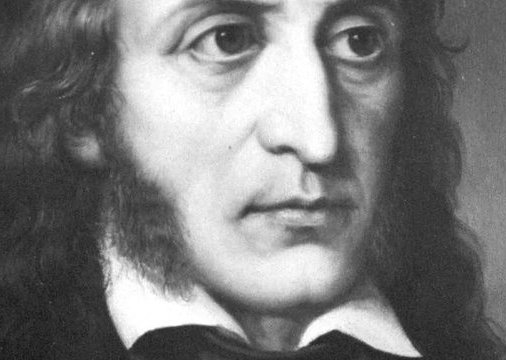By Nicoletta Sciarrone
 A man of many souls, genius not taken for granted, with a lively intelligence that placed him far ahead of his time, Niccolò Paganini was a person with disabilities - as he recently discovered - deemed devoid of any manual ability, or the nineteenth-century equivalent of a sentence to marginalization. However, he did not surrender to his condition and, long before the concept of inclusion was acquired by society, he struggled to establish himself, sublimating the disease into music.
A man of many souls, genius not taken for granted, with a lively intelligence that placed him far ahead of his time, Niccolò Paganini was a person with disabilities - as he recently discovered - deemed devoid of any manual ability, or the nineteenth-century equivalent of a sentence to marginalization. However, he did not surrender to his condition and, long before the concept of inclusion was acquired by society, he struggled to establish himself, sublimating the disease into music.
Talented, histrionic, lover of excesses, always far from conventions. Niccolò Paganini was not only one of the greatest violinists ever, a composer, among other things, of the famous Capricci for solo violin. He was also a man that for his characters of genius and unruliness even today would be extravagant, imagine what he thought of his contemporaries in the distant nineteenth century.
His hair was long and unkempt, his teeth were missing, the imposing aquiline nose stood out on his pale, bony face. Very thin and dark, he exalted these characters, always dressing in black and wearing glasses with blue lenses, because he knew that part of his fame was due to the aura of mystery that surrounded him. Therefore, those who consider him the “inventor of divism” are not wrong, the first music star to treat his image in a maniacal way, fueling the myth of himself with careful marketing strategies. In fact, at the peak of their careers, men dressed their hair à la Paganini, prepared sweets with their name, in Vienna the 5 florin money was called Paganinerl, the surname Paganini was used as a noun to define any virtuoso.
However, the dark aspect and the cleverness do not take away the qualities of the musician. His masterful performances enchanted his colleagues at the time: “I heard an angel sing,” said Franz Schubert, not to mention the likeable but no less flattering comment by Gioacchino Rossini: “Only twice I cried in my life: when a turkey stuffed of truffles accidentally fell into the water and when I heard Paganini play”.
In recent times, it was discovered that his extraordinary artistic skills were probably “enhanced” by a rare disease, Marfan syndrome, which alters the connective tissue and compromises various organ systems, including the skeleton. Many illustrious figures suffered from it: the president of the United States Abraham Lincoln, the French Charles De Gaulle, even seems the pharaoh Akhenaten. Paganini’s descriptions refer to long arms, hands with long, tapered fingers and disproportionate feet that moved to the rhythm of the music, wriggling the slim body into impossible poses. He knew how to make a virtue of necessity, he used to his benefit the anatomical characteristics due to the pathology of which he was then unknown, and reached levels of incomparable virtuosity with a grueling daily training, to make his fingers flexible and elastic.
If on the one hand, however, disability brought him to glory, on the other hand, it caused him much suffering. Since childhood, in fact, its existence was marked by a very fragile health and by medical vicissitudes and therapies often more harmful than evil. How could a disabled person live in the nineteenth century, moreover ingenious, dissolute and eccentric? Let us know the “Jimi Hendrix of the violin”, revealing the person behind the character.
The life
On October 27, 1782, in Vico Fosse del Colle, a typical tortuous caruggio of Genoa in Italy was born Niccolò Paganini. It is useless to look for it, it has been demolished, yet the history of music counts him among the most representative places. It was the third of six children, mother Teresa Bocciardo had to work hard, while father Antonio was making ends meet by packing for the port.
Childhood was not the happiest. The father, passionate about music, with the sound of beating forced Niccolò to practice with the violin, locking it in a room for even twelve consecutive hours to study. The boy showed a talent out of the ordinary that certainly did not need such constraints to emerge. He began to perform in the churches of Genoa and, presaging a mocking character, one day, during Mass, he replaced the sacred melodies with the verses of the animals, perfectly reproduced with the faithful stringed instrument.
In 1796, his father Antonio brought him to Parma to consolidate his formation as a composer. The health of the young man was however delicate, he fell ill with pneumonia and was forced to rest.
Niccolò embodied the boy prodigy, but he was also the new artist who was stupefied by his attitudes and stage presence. He began the concerts with woody marionette movements, improvised, played with two fingers, while with another three he would pinch an accompaniment and went on undeterred even when some instrument strings broke. If the criticisms were negative, quadruple the price of the ticket and people still flocked. The skill was such that rumors soon spread over an alleged pact with the devil to promote success. Some swore to have seen the devil move the bow of the violin, while Paganini was on stage and when during a concert in Vienna a blind spectator asked how many they were playing, the answer "is one", he exclaimed, “then it is the devil.”
Gossiping typical of the cultural climate of the Romantic era, however, the direct concerned did not deny, satisfied with the popularity that derives from it, even if with the most intimate friends he regretted it: “To tell you the truth I regret that the opinion spreads in all classes that I have the devil on”.
He began to frequent unrepeatable companies, surrounding himself with a court of parasites and dissipating fortunes at the gaming table. It was objectively bad, but the women did not resist. “I'm not handsome, but when they listen to me, women all fall to my feet,” he said to himself. Even Elisa and Paolina Bonaparte, sisters of Napoleon, gave in to his charm. Only the tormented relationship with singer Antonia Bianchi gave him one of the greatest joys of life: his son Achilles. Come to light in 1825, three years later the child was abandoned by his mother and Paganini took care of him with unconditional dedication and love, seeing his affection reciprocated even in the most difficult moments.
As mentioned, his health conditions were precarious and the tours he underwent in Italy and Europe exhausted him beyond measure. Constant physical problems and the weariness of the movements undermined him in the body and in the spirit, so much to make him confess to a friend the desire to abandon forever the exercise of the violin. In 1830, a painter who gave him a portrait described him as tired and full of life. In 1833, he bought a villa in Gaione, in the Parma countryside, to get closer to his friends and rest in the breaks granted by his work. Starting from 1834, more striking and debilitating symptoms began and a pulmonary pathology with severe coughing access occurred. As if that were not enough, Paganini was hypochondriac and added up imaginary problems to real ones. He drank purges in massive doses and had leeches applied; what is worse, he took mercury to "cure" syphilis; a therapy that today we know is poisonous.
Despite the precarious health, in 1836 he accepted the task of reforming the Ducal Orchestra of Parma, but his vision too advanced for his times led the mission to failure.
In his later years, he became completely aphonic and, like Beethoven before him, was forced to communicate with the world in writing. Ironically, in those years also the "voice" of his beloved "cannon", which he considered an extension of himself, became weaker.
He died in Nice on May 27, 1840, at the age of 58. Always unpopular to the Church for the intemperance and the scandals, despite not being atheist, he was denied the funeral and burial in consecrated ground. The body ended up in the Lazzaretto of Villefranche-sur-Mer, was then embalmed and exhibited for a fee in a macabre tour. The corpse also reached a fish market, where people looked at him curiously, while shopping. It was Gaione’s friends who snatched him from this sad destiny and wanted to bury him in the country, next to them.
From 1876, it rests in a neoclassical temple in the Villetta Cemetery, in Parma. On the grave is engraved an eagle that flies upwards holding a violin with its beak.
The man
To understand the personality of Paganini and its relationship with the disease we must shake off the anecdotal of the official biography, full of fictional episodes created to enhance the suggestion around the character. Take, for example, the famous phrase “Paganini does not repeat”, which was not at all, as you think, a normal intercalary due to its excessive nature. He only said this once in response to King Carlo Felice of Savoy, who had asked him for an encore. He improvised, so each of his performances was unique and unrepeatable. Then he played with such ardor that he often ended up exhausted with bleeding fingertips. The shamelessness cost him dear: he was in fact expelled for two years from the Kingdom of Savoy, which gave him the opportunity to coin a typical way of saying: “The great do not fear, the humble not disdain.”He showed his generous side to the most humble. In fact, we have witnessed gifts donated to family members and musicians in difficulty; it was also usual to give performances whose proceeds destined to the poor and the sick of the cities in which he performed. Another rumor is denied, that on the extreme avarice of Paganini. Many voices have also circulated on his personality. As a young man, he had a fluctuating character that, to a modern psychological vision, we could attribute to mood alterations in a depressive sense, with manic tips. It is likely that the “madness” was partly a reaction to the coercion suffered by his father.
Lost the use of the word, before relying on written tickets, Paganini had in Achille the interpreter of his thoughts, given that the young man had become accustomed to reading the words on his father's lips. Their relationship was symbiotic to the point that, at the death of the Master, the son dedicated himself to the reorganization of his father's work and transmitted the affection for his grandfather Niccolò to his nephews, who never knew him in person, but handed down his memory, giving the Italian State the entire Paganini work.
Today, as mentioned, we know that in all probability Paganini was affected by Marfan syndrome, a theory confirmed by recent investigations conducted in the MAGI Laboratory in Rovereto (Trento), specialized in genetic tests on the most known hereditary vascular malformations (Marfan syndrome, in fact, besides striking the skeleton, it attacks the cardiovascular system and the eyes).
Only in 1896, or 56 years after the death of the musician, for the first time, the French pediatrician Antoine Marfan described this rare disease, observing it on a 5-year-old girl. Paganini could therefore not rely on a diagnosis nor on adequate therapies.
This explains his wandering from one doctor to another, in a continuous alternation of hopes and disillusions.
He did not have a good opinion of the medical profession, yet he did not hesitate to ask some of the most distinguished European specialists of his time.
The reaction to the deterioration of health conditions was dignified, never gave in to despair and showed great strength of mind.
His hands had always had an extraordinary mobility that he, as few as professional, had increased with a devoted application to the study. “If I do not study for a day, I'll just notice it, if I do not study for two days, everyone will notice it,” he repeated.
Niccolò Paganini was a man of many souls, a genius not taken for granted with a lively intelligence that placed him ahead of his century. He was a person with disabilities, was judged devoid of any manual ability, the nineteenth-century equivalent of a sentence to marginalization. He did not surrender to his condition and, long before the concept of inclusion was acquired by society, he struggled to establish himself, sublimating the disease into music.
I really love this musician who makes me think that in the midst of the objective difficulties that life presents us, we must not give up. I think then that every translator is an artist, and a piece of music comes out of the pages when he translates. Never a translation is the same as another; if I were to translate the same passage many times, I would always do it in a new way, always with renewed impetus, working and chiseling every word. I think this is the challenge for those who use their minds and their hands to transmit messages, to create bridges. Literature, a written page, any text, are on this side of the bridge before being interpreted. They exist because someone puts their hands on them, works them: the text becomes something other than itself, acquires its own dimension, its thickness, its importance. It becomes understandable, therefore reproducible in space and time.
Who uses the mind to generate works of art and the hands to express them is like a translator who with his mind and his hands generates a text to the new life of a foreign language.





